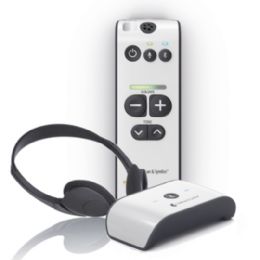
Personal listening systems are devices that help those with hearing, speech, voice, and language disabilities communicate and participate more fully in their daily lives.
Rehabmart is pleased to carry a wide variety of high quality assistive listening devices from superior quality vendors such as Posey, Enabling Devices, LSS, Harris Communications, MaxiAids and Hearmore.







.jpg&newheight=260&quality=80)
.jpg&newheight=260&quality=80)





~1.jpg&newheight=260&quality=80)
What are Personal Listening Systems?
Personal listening systems, or assistive listening devices, are used by those with all degrees of hearing loss to hear and understand what is being said more clearly. They also help people with a speech, voice or language disorder communicate and express thoughts easier.
These devices amplify and clarify the sounds a person wants to hear and help to overcome background noises and poor acoustics when talking one-on-one or engaging in small group conversations. Since the development of digital and wireless technologies, more devices are becoming available to help those with speech and hearing disorders, so they can communicate and participate more effectively in their everyday lives.
Assistive listening devices can also be used with a cochlear implant or hearing aid to help the user hear certain sounds better, since those aids and implants have limitations and do not work well in all situations. Because the assistive devices help extend the reach and effectiveness of hearing aids and cochlear implants, they are sometimes described as “binoculars for the ears.”
What Types of Assistive Listening Devices are Available?
There are several types of listening devices available to improve sound transmission for those with hearing loss, and all of them can be used with or without hearing aids or cochlear implants. Some are designed for large areas, such as theaters, airports, classrooms and places of worship. These include hearing loop systems, infrared systems, and frequency-modulated (FM) systems. Others are designed for personal use for one-on-one and small group conversations.
What are Hearing Loop Systems?
A hearing loop is a special type of sound system used by those with or without hearing aids. It provides a magnetic and wireless signal that is picked up by the hearing aid or headset of the user. Hearing loops cut out unwanted background noise, are inconspicuous, cost effective, and any number of users can use the system. The sound is much clearer because it is picked up directly by the receiver.
A hearing loop system consists of a sound source, such as a microphone, home TV, telephone or public address system; the loop cable, which is a thin loop of wire place around the perimeter of a specific area, such as a church room or meeting room; an amplifier, and a receiver worn in the ears or as a headset.
What are Infrared Systems?
Infrared systems are assistive listening devices that use infrared light to transmit sound into a light signal and beam it to a receiver worn by a listener. Then it decodes the infrared signal back to sound, guaranteeing privacy because light does not pass through walls.
This makes them an appropriate choice for situations that require confidentiality, such as a court room, and in buildings where competing signals can be a problem, such as a classroom or movie theater. But they cannot be used in situations with too many competing light sources, such as outdoors or in strongly lit rooms.
What are Frequency-Modulated (FM) Systems?
FM systems use radio signals to transmit amplified sounds, and are very useful and popular in educational settings or at conferences to maximize the instructor’s voice. The instructor wears a small, portable microphone that is usually clipped to his or her collar. The microphone is connected to a transmitter and the student wears the receiver, which is tuned to a specific frequency, or channel. The sound is delivered wirelessly to the student’s receiver, or hearing aid, using the FM signal, avoiding background noises and echoes.
FM systems can be used in many public places and can transmit signals up to 300 feet. But listeners in one room may need to listen to a different channel than those in another room to avoid receiving mixed signals, because radio signals can penetrate walls.
Personal FM systems operate in the same way as the larger systems and can be very helpful for those with hearing loss to follow one-on-one conversations or to utilize for other listening situations.
What are Personal Sound Amplifiers?
Personal sound amplifiers help those with hearing loss hear better in small group settings and one-on-one conversations, such as when watching TV, traveling in a car, or being outdoors. They are about the size of a cell phone and they increase sound levels and decrease background noises for the listener. Some have directional microphones that can be angled toward a speaker or other source of sound, and the amplified sound can be picked up by the receiver that the listener is wearing, such as a headset or earbuds.
Personal sound amplifiers are very discreet listening devices worn in the ear, and are great for classrooms, churches, or any place where you are a distance away from the speaker.
Hulet Smith, OT
Rehabmart Co-Founder & CEO
lb